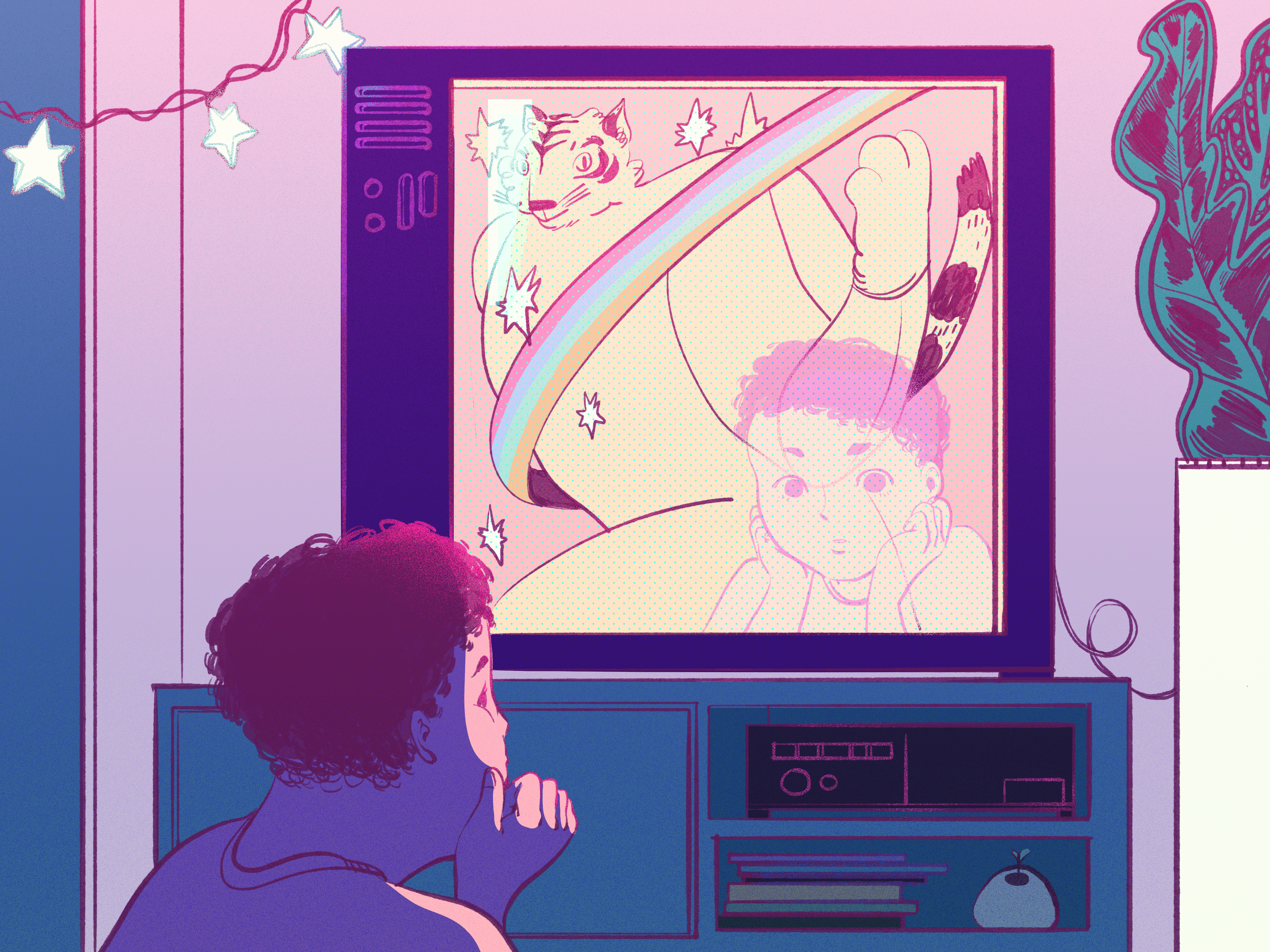While crossing the road in front of my school, I was hit by a car.
My last thought before blacking out was a horrified realization that I would miss that evening’s episode of Thundercats.
I was a 10-year-old boy secretly in love with a cartoon tiger. I couldn’t tell anyone about my feelings because that cartoon tiger was a man.
“The reason I kept my crush a secret was that it would expose me as gay — something I was still only beginning to understand about myself.”
My early adolescent crush was on Tygra of the television series Thundercats, a group of feline heroes fighting an evil sorcerer. Tygra was the stoic, slim-hipped, leotard-clad brains of the group. Manlier than his brattish compatriot Lion-O, less butch than the beefcake character Panthro, Tygra was the just-right Thundercats hunk, sparking some of my earliest feelings of queer lust. The episode I missed was the one about a Satanic goat-man who tied Tygra up with his own whip. I would have really enjoyed it.
There are a few reasons a 10-year-old might keep his affection for a cartoon cat man a secret, but I was too young to know about the kink-shaming of furries, and young enough to ignore grown-up disdain for cartoon crushes. The reason I kept my crush a secret was that it would expose me as gay — something I was still only beginning to understand about myself.
I didn’t even want people to know that Tygra was my favourite — just liking him felt obviously gay. He seemed so sexual to my proto-sexual self, with his broad shoulders and narrow waist, his warm baritone and his asymmetrical costume replete with a plunging V-neck and gold accents. Even his personal theme tune was a heady gay mix of sporty macho brass and cascading disco synths.
“In a media landscape where little else resonated, Snarf felt queer in the way I felt queer.”
I decided to pretend that a different Thundercat was my favourite, and there’s where I made a huge tactical error. I should have picked the hero Lion-O, or strongman Panthro, or exuberant Wilykat.
Instead, I picked Snarf.
There are probably few more obviously queer-coded characters in children’s animation. Snarf was a prissy nursemaid known for his snide asides and unending stream of anxieties. He was an outsider among the outsiders, a weird squat lizard-skunk among sexy human-cat beings. And people hated him. He was shrill, irritating and cowardly.
Yet I actually did love Snarf. His resilient effeminacy and shrieking fussiness in a world of swaggering fighters resonated with me in ways that it clearly didn’t for my Snarf-phobic schoolmates. I saw myself in his rejection of masculinity, his yearning for empathy and his need to make himself useful by mothering everyone around him.
“This was progress, but the sort of progress we only cheer for because we’ve been denied any sort of representation until now.”
Sure, the other Thundercats were kinda gay too. Lion-O was a spunky twunk with a phallic sword that grew when he was excited. Panthro was a butch bald leather daddy. Cheetara had the breathy voice and heavy eye make-up of a torch singer. But a 10-year-old couldn’t see those things. In a media landscape where little else resonated, Snarf felt queer in the way I felt queer.
Recently, something new appeared on that landscape. The makers of the Netflix animated show Voltron: Legendary Defender announced at a panel at San Diego Comic-Con that one of its main characters, Shiro, is gay. Like Tygra, Shiro is a smart and serious big brother figure who provides a sober contrast to the hot-headed frontman — and boasts excellent eyebrow game. Shiro’s sexuality was revealed to fans at the convention in a video clip that introduced his male ex. This announcement felt huge to me, because I knew what it would have meant to my 10-year-old self to see a character like Shiro be queer, seen and accepted by his friends — I would’ve realised that I wasn’t alone and that maybe I could hope to find acceptance as well.
But then I watched the episodes. Voltron killed off Shiro’s ex so they would never have to actually put a same-sex romance on screen, and the show was careful never to use any language or show any action that would definitively establish the characters’ queerness for casual viewers. This was progress, but the sort of progress we only cheer for because we’ve been denied any sort of representation until now.
I understood then why Snarf could be queer-coded. He’s a clown. Characters like Snarf, the magician Orko in Masters of the Universe and unicorn pal Uni in Dungeons & Dragons could be effeminate and shrill because they were there to be laughed at. Shiro had to be taken seriously, so there was only so much queer he was allowed to be.
The only other set of characters besides comedy sidekicks who are as consistently coded as queer are villains. Take, for example, Skeletor in Masters of the Universe, whose withering wit and melodramatic flair read as undeniably queeny to modern eyes. Other examples include Venger in Dungeons & Dragons and Zoltar in Battle of the Planets. Clowns and villains are allowed to be effeminate, subversive, theatrical and outrageous, because they exist in contrast to the butch masculine normie heroes.
“Kids’ entertainment will only let you be queer-coded if you’re laughable or evil — the same thing I was always taught in the playground.”
And these tropes persist. Voltron has its own prissy nursemaid character, Coran, plus a pair of villains implied to be queer women who were seemingly blown up in the same season where Shiro “came out.” Kids’ entertainment will only let you be queer-coded if you’re laughable or evil — the same thing I was always taught in the playground. If you’re queer, you’re either a joke or a threat. You’re never the hero.
Snarf and Tygra were both important to my young queer self: Tygra was a crush and part of finding out who I am, and even as an unflattering stereotype, Snarf gave me something to cling to when there was nothing else around. Yet the fact that Snarf could read queer and Tygra definitely couldn’t is a manifestation of a homophobic culture.
The solution is not to let hero characters like Shiro be gay, but to allow queer-coded characters like Snarf to be heroes as well. Let the effeminate men and butch women and swishy subversives save the day.
“If you’re queer, you’re either a joke or a threat. You’re never the hero.”
The queer villains also have a lot to teach us, because there is power in being the outcast and rejecting the status quo, and there is joy in living your truth. Loud, cackling joy. With fabulous outfits and better hats.
In the thirty years since I was an obsessive Thundercats fan, kids’ shows like Steven Universe and The Legend of Korra have chipped away at heteronormativity, with a same-sex wedding in the former and same-sex hand-holding in the latter. These victories are still few and far between, and the tropes and conventions of children’s entertainment still treat queerness like a dirty secret that kids need to be protected from, except when trotting out old familiar stereotypes.
Right before the car hit me 30 years ago, I worried about what I was about to miss. A generation later, it turns out I didn’t miss much.



 Why you can trust Xtra
Why you can trust Xtra


